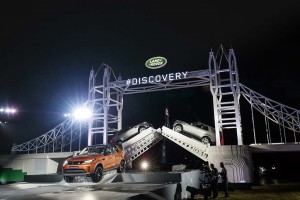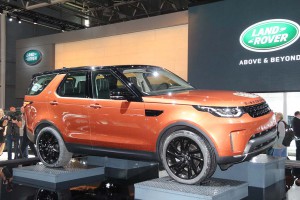
The new Land Rover Discovery makes its debut alongside a replica of London's Tower Bridge using nearly 6 million Lego blocks.
It took nearly 6 million Lego blocks to set the stage for the debut of the all-new Land Rover Discovery.
The new seven-seat SUV, which replaces the old LR4 model, got a novel send-off ahead of its Paris Motor Show debut, emerging alongside the largest Lego structure ever built – a reproduction of London’s familiar Tower Bridge that took 5,805,846 of the blocks. That was enough to stretch from London to Paris, earning it a place in the Guinness Book of World Records.
That said, Land Rover isn’t playing around. The three-row Discovery is the latest in a fast-growing line-up of luxury utes from the British-based, Indian-owned automaker. It joins the smaller Discovery Sport model launched a year ago, with a third “Disco” variant still in the works.
Beyond the Evoq roof line and grille, the new Land Rover Discovery might trigger a sense of déjà vu for those who recall the Discovery Vision Concept that made an out-of-this-world debut during a New York Auto Show preview in April 2014. The show car was unveiled alongside a mock-up of the Virgin Galactic Enterprise, the world’s first commercial manned spacecraft, aboard the retired aircraft carrier, the USS Intrepid.
The new Land Rover Discovery also borrows from the Range Rover Evoq, the most popular model in the brand’s history, starting with the distinctively sloped roof line. The three-row Disco is distinguished by more modern headlamps and LED running lights, a more steeply raked windshield, and a more elegantly sculpted body than the outgoing model.
While not exactly into sports car territory, its drag coefficient has been reduced to 0.35, something that should translate into improved fuel economy and lower wind noise.
In back, there are new LED taillamps, a new spoiler that will make it easier to load and unload cargo.
“The Discovery Vision set the tone, alluding to a radical departure in design for the Discovery family,” said Land Rover head of design Gerry McGovern. The result is a “more compelling statement to our customers.”
(Paris Motor Show brings big launches, but key makers absent. For more, Click Here.)
The interior makes a move up-market compared to the old Discovery/LR4, with more premium leather and wood options, as well as new infotainment technology. One of the new, high-tech touches is the so-called Activity Key. Borrowed from the Jaguar F-Pace, it allows the driver to leave behind the conventional key fob, instead wearing a simple bracelet similar to popular fitness monitors. It’s useful when biking or swimming, for example.
There’s also a new Intelligent Seat Fold system that makes it easier to get into the back row or fold away the seats for large cargo.
The new Land Rover Discover measures 195.7 inches in length, making it 5.5 inches longer than the old model. At 87.4 inches, it’s also 1.5 inches wider – though it stands 1.6 inches lower. There’s more room for adult passengers in all three rows, and the middle seats can slide fore or aft a total of 6.3 inches.
The new Disco migrates to a lighter, more efficient architecture, in line with other new Jaguar Land Rover models. It is promised to deliver improved on-road driving manners, but the maker claims it retains the off-road capabilities that have long been a Land Rover hallmark. The new model sheds a full 1,000 pounds compared to the old LR4.
(Click Here for details about Land Rover teasing the new “Disco.”)
The goal is to “appeal to consumers on multiple levels,” explained engineering director Nick Rogers.
On the powertrain side, Land Rover will offer a wide range of engines for various global markets, including a 254-horsepower, 3.0-liter turbo-six diesel that can launch the Discovery from 0 to 60 in just 7.7 seconds. That’s cut to 7.1 seconds when equipped with the 340 horsepower supercharged 3.0-liter gas engine. Both engines will be offered in the U.S. paired to a ZF eight-speed automatic.
The new Disco gets a rear integral link suspension, with a double-wishbone up front. An air suspension is optional. It is designed to improve both comfort and control, rising 2.95 inches, when needed, for added ground clearance, or dropping 2.36 inches for easier access to the cabin.
Several different all-wheel-drive systems will be available, including a full-time system with a Torsen Differential and single-speed transfer box, or a two-speed transfer box.
(Forget sports cars. SUVs set to dominate luxury market. Click Here for more.)
And like other recent LR models, drivers will be able to adjust a variety of settings – such as ride height, transmission shifting, throttle response and steering – using the maker’s Terrain Response Control system.
U.S. models will start at $49,990 and run to $73,950 for the heavily contented Discovery First Edition. The new model reaches U.S. showrooms in mid-2017.

